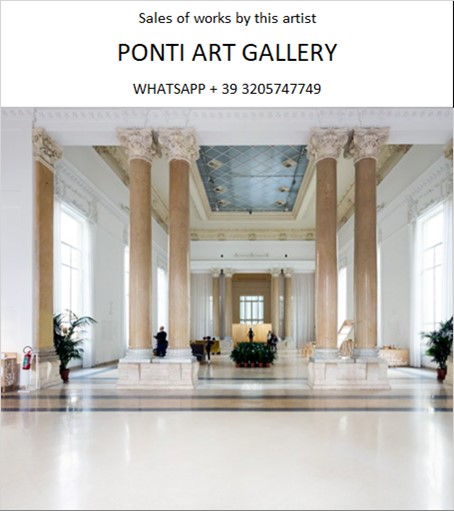Ponti Art Gallery is interested in buying and selling works
of art by this artist.

Edgar Samuel-Paxson Biography
Edgar Samuel Paxson was a distinguished American frontier painter, scout, soldier, and writer, whose work primarily focused on the depiction of Native Americans in the Old West and the historic Battle of Little Bighorn. Born on April 25, 1852, in East Hamburg, New York, to a Quaker family, Paxson spent his formative years in the woodlands of New York and Pennsylvania. His childhood was steeped in the wilderness, where he learned to hunt and trap game, skills imparted by his uncles.
The tales of the American frontier, brought back by his uncles who had ventured west during the California Gold Rush, and the stories from family friends who lived among the Seneca Nation, ignited Paxson's imagination and wanderlust. By the age of ten, he was already contributing to the war effort as a drummer boy for new recruits during the American Civil War. His encounters with notable figures such as Kit Carson and Captain Jack Crawford, the "Poet Scout," in New York, further fueled his desire to explore the West.
In his early twenties, Paxson embarked on his journey across America, traveling from Kansas to Canada. He eventually settled in Deer Lodge, Montana, with his wife Laura Millicent Johnson and their child Loren. In Deer Lodge, Paxson began his professional art career, painting signage and scenic backdrops for theatrical performances. His love for the outdoors never waned, and he often went on hunting and camping trips, writing articles about trapshooting and hunting under the pseudonym "Pistol Grip."
Paxson's artistic journey was largely self-taught, with his early experience in painting carriages and signs for his father's business laying the foundation for his skills as an artist. Despite the lack of formal art training, Paxson's talent was evident in his detailed and historically accurate depictions of Western life. His move to Butte, Montana, in 1881 marked a significant turn in his career as he established a studio and began producing easel paintings of historical subjects and portraits of Indians.
One of Paxson's most defining works was his painting "Custer's Last Stand," which he began after arriving in Montana in 1877, the year following the Battle of the Little Bighorn. His fascination with the battle led him to conduct extensive research, interviewing participants from both sides, including Native American leaders like Gall (Lakota) and Two Moon (Tsistsistas), and military figures such as General E.S. Godfrey. Paxson's dedication to accuracy was such that General Godfrey was moved to tears by the painting's ferocity and precision.
The creation of "Custer's Last Stand" was a six-year endeavor, culminating in a detailed canvas that featured over two hundred figures. Paxson's meticulous approach included individual figure studies and a scaled-down pen and ink version to outline the figures. The painting was later taken on a tour around America, with an accompanying booklet that provided an outline key to the figures, a history of the battle, and information on the painting itself.
Paxson's contributions to art extended beyond his studio. He was actively involved in the Montana National Guard, where he developed friendships with military leaders of the region. His murals at the Missoula County Courthouse and the State Capitol are notable for their adherence to historical accuracy, depicting events such as stops on the Lewis and Clark journey and the signing of the treaty at Council Grove.
Despite the challenges of being an artist in the frontier, Paxson's work gained recognition, and he was elected to membership in the Society of Associated Arts. He exhibited his paintings at various expositions, including the Louisiana Purchase Exposition in St. Louis and the Lewis and Clark Exposition in Portland. Paxson's legacy is one of a pioneer painter whose brush told stories of the Old West with a fidelity that continues to captivate audiences to this day.
Edgar Samuel Paxson passed away on November 9, 1919, in Missoula, Montana, at the age of 67. His friend and fellow artist, Charles Marion Russell, offered a tribute to Paxson, acknowledging his love for the Old West and the enduring quality of his artwork. Paxson's paintings remain a testament to his skill, his passion for the American frontier, and his commitment to preserving its history through his art.
Edgar Samuel-Paxson Quotes and
Sales of Works
Ponti Art Gallery selects and deals with paintings by the
artist. Upon request, we provide free estimates and
evaluations, communicate prices, quotations, and current
market values.
If you are interested in BUYING or SELLING works by the
artist, contact us immediately.
If you wish to sell or receive an evaluation of the
works:
Send us a frontal photo of the painting, one of the back,
and one of the signature. Also, indicate the dimensions of
the work. Inform us about the purchase origin of the work
and any kind of available documentation (purchase
receipts, certificates of authenticity, publications). One
of our operators will respond to you on the same day. We
guarantee maximum confidentiality and extreme
professionalism.
If you wish to purchase works by the painter: Contact us
and let us know your request. We will inform you about the
available works. We also offer the possibility to
subscribe to our NEWSLETTER, through which you will be
informed at the beginning of each month about the latest
acquisitions of the art gallery.
You can send us pictures of the work:
